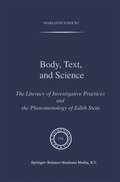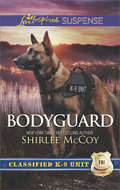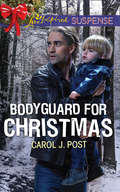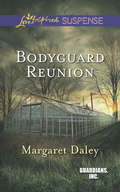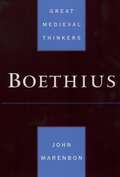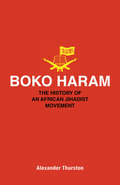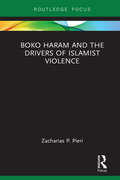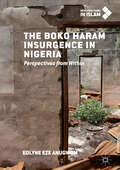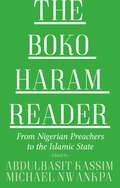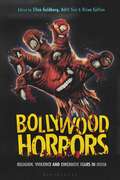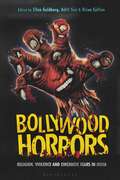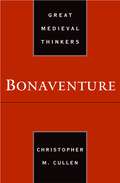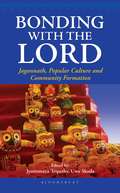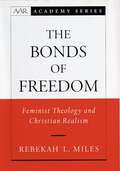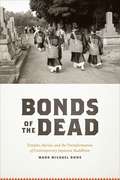- Table View
- List View
Body, Text, and Science: The Literacy of Investigative Practices and the Phenomenology of Edith Stein (Phaenomenologica #144)
by M. SawickiWhat is "scientific" about the natural and human sciences? Precisely this: the legibility of our worlds and the distinctive reading strategies that they provoke. That account of the essence of science comes from Edith Stein, who as HusserI's assistant 1916-1918 labored in vain to bring his massive Ideen to publication, and then went on to propose her own solution to the problem of finding a unified foundation for the social and physical sciences. Stein argued that human bodily life itself affords direct access to the interplay of natural causality, cultural motivation, and personal initiative in history and technology. She developed this line of approach to the sciences in her early scholarly publications, which too soon were overshadowed by her religious lectures and writings, and eventually were obscured by National Socialism's ideological attack on philosophies of empathy. Today, as her church prepares to declare Stein a saint, her secular philosophical achievements deserve another look.
Bodyguard For Christmas: Holiday Amnesia Bodyguard For Christmas Perilous Christmas Reunion (Mills And Boon Love Inspired Suspense Ser.)
by Carol J. PostSomeone’s after his little boy. She has one chance to save them both.
Bodyguard Reunion: Guarding The Witness Bodyguard Reunion (Guardians, Inc. #6)
by Margaret DaleyREUNIONS CAN BE DEADLY
Boethius (Great Medieval Thinkers)
by John MarenbonThis book offers a brief, accessible introduction to the thought of Boethius. After a survey of Boethius's life and work, Marenbon explicates his theological method, and devotes separate chapters to his arguments about good and evil, fortune, fate and free will, and the problem of divine foreknowledge. Marenbon also traces Boethius's influence on the work of such thinkers as Aquinas and Duns Scotus.
Boethius (Great Medieval Thinkers)
by John MarenbonThis book offers a brief, accessible introduction to the thought of Boethius. After a survey of Boethius's life and work, Marenbon explicates his theological method, and devotes separate chapters to his arguments about good and evil, fortune, fate and free will, and the problem of divine foreknowledge. Marenbon also traces Boethius's influence on the work of such thinkers as Aquinas and Duns Scotus.
Boko Haram: The History of an African Jihadist Movement (Princeton Studies in Muslim Politics #65)
by Alexander ThurstonA comprehensive history of one of the world's deadliest jihadist groupsBoko Haram is one of the world’s deadliest jihadist groups. It has killed more than twenty thousand people and displaced more than two million in a campaign of terror that began in Nigeria but has since spread to Chad, Niger, and Cameroon as well. This is the first book to tell the full story of this West African affiliate of the Islamic State, from its beginnings in the early 2000s to its most infamous violence, including the 2014 kidnapping of 276 Nigerian schoolgirls.Drawing on sources in Arabic and Hausa, rare documents, propaganda videos, press reports, and interviews with experts in Nigeria, Cameroon, and Niger, Alexander Thurston sheds new light on Boko Haram’s development. He shows that the group, far from being a simple or static terrorist organization, has evolved in its worldview and ideology in reaction to events. Chief among these has been Boko Haram’s escalating war with the Nigerian state and civilian vigilantes.The book closely examines both the behavior and beliefs that are the keys to understanding Boko Haram. Putting the group’s violence in the context of the complex religious and political environment of Nigeria and the Lake Chad region, the book examines how Boko Haram relates to states, politicians, Salafis, Sufis, Muslim civilians, and Christians. It also probes Boko Haram’s international connections, including its loose former ties to al-Qaida and its 2015 pledge of allegiance to ISIS.An in-depth account of a group that is menacing Africa’s most populous and richest country, the book also illuminates the dynamics of civil war in Africa and jihadist movements in other parts of the world.
Boko Haram: The History of an African Jihadist Movement (Princeton Studies in Muslim Politics #65)
by Alexander ThurstonA comprehensive history of one of the world's deadliest jihadist groupsBoko Haram is one of the world’s deadliest jihadist groups. It has killed more than twenty thousand people and displaced more than two million in a campaign of terror that began in Nigeria but has since spread to Chad, Niger, and Cameroon as well. This is the first book to tell the full story of this West African affiliate of the Islamic State, from its beginnings in the early 2000s to its most infamous violence, including the 2014 kidnapping of 276 Nigerian schoolgirls.Drawing on sources in Arabic and Hausa, rare documents, propaganda videos, press reports, and interviews with experts in Nigeria, Cameroon, and Niger, Alexander Thurston sheds new light on Boko Haram’s development. He shows that the group, far from being a simple or static terrorist organization, has evolved in its worldview and ideology in reaction to events. Chief among these has been Boko Haram’s escalating war with the Nigerian state and civilian vigilantes.The book closely examines both the behavior and beliefs that are the keys to understanding Boko Haram. Putting the group’s violence in the context of the complex religious and political environment of Nigeria and the Lake Chad region, the book examines how Boko Haram relates to states, politicians, Salafis, Sufis, Muslim civilians, and Christians. It also probes Boko Haram’s international connections, including its loose former ties to al-Qaida and its 2015 pledge of allegiance to ISIS.An in-depth account of a group that is menacing Africa’s most populous and richest country, the book also illuminates the dynamics of civil war in Africa and jihadist movements in other parts of the world.
Boko Haram and the Drivers of Islamist Violence
by Zacharias P. PieriThis book analyzes the factors that drive Boko Haram’s violence, arguing that the movement is rooted in the historical and religious context of west Africa. The data presented is based on extensive research, including fieldwork in Nigeria, primary source analysis, archival work, and large-scale survey analyses. Each chapter deals with a different case-study that showcases a driver of Boko Haram’s violence, including how the jihad of Usman dan Fodio is used as a source of contemporary inspiration to Boko Haram; how the extrajudicial killing of its then leader Mohammad Yusuf spurred the group to violence; why the kidnapping of the Chibok schoolgirls was motivated by both ideology and strategy; how the formation of a caliphate and pledging of allegiance to ISIS gave Boko Haram an amplified presence; and how the issue of takfir led to the fracturing of the movement. To succeed in the fight against Boko Haram, this book argues, the Nigerian state needs to couple military advances with deep social changes, such as combatting corruption, reforming the police, and investing equitably across the country. This book will be of much interest to students of terrorism and political violence, African politics, war and conflict studies, and security studies in general.
Boko Haram and the Drivers of Islamist Violence
by Zacharias P. PieriThis book analyzes the factors that drive Boko Haram’s violence, arguing that the movement is rooted in the historical and religious context of west Africa. The data presented is based on extensive research, including fieldwork in Nigeria, primary source analysis, archival work, and large-scale survey analyses. Each chapter deals with a different case-study that showcases a driver of Boko Haram’s violence, including how the jihad of Usman dan Fodio is used as a source of contemporary inspiration to Boko Haram; how the extrajudicial killing of its then leader Mohammad Yusuf spurred the group to violence; why the kidnapping of the Chibok schoolgirls was motivated by both ideology and strategy; how the formation of a caliphate and pledging of allegiance to ISIS gave Boko Haram an amplified presence; and how the issue of takfir led to the fracturing of the movement. To succeed in the fight against Boko Haram, this book argues, the Nigerian state needs to couple military advances with deep social changes, such as combatting corruption, reforming the police, and investing equitably across the country. This book will be of much interest to students of terrorism and political violence, African politics, war and conflict studies, and security studies in general.
The Boko Haram Insurgence In Nigeria: Perspectives from Within (New Directions in Islam)
by Edlyne Eze AnugwomThis book focuses on the Boko Haram insurgence in Nigeria, and provides information on the origin and growth of the sect, antecedent and historical factors behind the insurgence, assessing a variety of socio-political drivers. The structure, organization and ideology of the sect are analysed, paying attention to internal splits within the group, as well as external relations with the Nigerian state, and global jihadism. The diverse and wide ranging issues covered in the book makes it valuable for academic researchers, students and policy practitioners both within Africa and beyond.
The Boko Haram Reader: From Nigerian Preachers to the Islamic State
by Abdulbasit Kassim and Michael NwankpaSince it erupted onto the world stage in 2009, people have asked, what is Boko Haram, and what does it stand for? Is there a coherent vision or set of beliefs behind it? Despite the growing literature about the group, few if any attempts have been made to answer these questions, even though Boko Haram is but the latest in a long line of millenarian Muslim reform groups to emerge in Northern Nigeria over the last two centuries. The Boko Haram Reader offers an unprecedented collection of essential texts, documents, videos, audio, and nashids (martial hymns), translated into English from Hausa, Arabic and Kanuri, tracing the group's origins, history, and evolution. Its editors, two Nigerian scholars, reveal how Boko Haram's leaders manipulate Islamic theology for the legitimisation, radicalization, indoctrination and dissemination of their ideas across West Africa. Mandatory reading for anyone wishing to grasp the underpinnings of Boko Haram's insurgency, particularly how the group strives to delegitimize its rivals and establish its beliefs as a dominant strand of Islamic thought in West Africa's religious marketplace.
The Boko Haram Reader: From Nigerian Preachers to the Islamic State
Since it erupted onto the world stage in 2009, people have asked, what is Boko Haram, and what does it stand for? Is there a coherent vision or set of beliefs behind it? Despite the growing literature about the group, few if any attempts have been made to answer these questions, even though Boko Haram is but the latest in a long line of millenarian Muslim reform groups to emerge in Northern Nigeria over the last two centuries. The Boko Haram Reader offers an unprecedented collection of essential texts, documents, videos, audio, and nashids (martial hymns), translated into English from Hausa, Arabic and Kanuri, tracing the group's origins, history, and evolution. Its editors, two Nigerian scholars, reveal how Boko Haram's leaders manipulate Islamic theology for the legitimisation, radicalization, indoctrination and dissemination of their ideas across West Africa. Mandatory reading for anyone wishing to grasp the underpinnings of Boko Haram's insurgency, particularly how the group strives to delegitimize its rivals and establish its beliefs as a dominant strand of Islamic thought in West Africa's religious marketplace.
Bollywood Horrors: Religion, Violence and Cinematic Fears in India
by Ellen Goldberg, Aditi Sen, and Brian CollinsBollywood Horrors is a wide-ranging collection that examines the religious aspects of horror imagery, representations of real-life horror in the movies, and the ways in which Hindi films have projected cinematic fears onto the screen. Part one, “Material Cultures and Prehistories of Horror in South Asia” looks at horror movie posters and song booklets and the surprising role of religion in the importation of Gothic tropes into Indian films, told through the little-known story of Sir Devendra Prasad Varma. Part two, “Cinematic Horror, Iconography and Aesthetics” examines the stereotype of the tantric magician found in Indian literature beginning in the medieval period, cinematic representations of the myth of the fearsome goddess Durga's slaying of the Buffalo Demon, and the influence of epic mythology and Hollywood thrillers on the 2002 film Raaz. The final part, “Cultural Horror,” analyzes elements of horror in Indian cinema's depiction of human trafficking, shifting gender roles, the rape-revenge cycle, and communal violence.
Bollywood Horrors: Religion, Violence and Cinematic Fears in India
Bollywood Horrors is a wide-ranging collection that examines the religious aspects of horror imagery, representations of real-life horror in the movies, and the ways in which Hindi films have projected cinematic fears onto the screen. Part one, “Material Cultures and Prehistories of Horror in South Asia” looks at horror movie posters and song booklets and the surprising role of religion in the importation of Gothic tropes into Indian films, told through the little-known story of Sir Devendra Prasad Varma. Part two, “Cinematic Horror, Iconography and Aesthetics” examines the stereotype of the tantric magician found in Indian literature beginning in the medieval period, cinematic representations of the myth of the fearsome goddess Durga's slaying of the Buffalo Demon, and the influence of epic mythology and Hollywood thrillers on the 2002 film Raaz. The final part, “Cultural Horror,” analyzes elements of horror in Indian cinema's depiction of human trafficking, shifting gender roles, the rape-revenge cycle, and communal violence.
Bolton Priory: The Economy Of A Northern Monastery, 1286-1325 (Oxford Historical Monographs)
by Ian KershawThe history of the priory, 1120-1330. The priory's exploitation of its estate. Pasture farming. Investment. Provisions and food consumption at the priory. The priory's finances. The last two centuries.
Bonaventure (Great Medieval Thinkers)
by Christopher M. CullenThe great Franciscan theologian St. Bonaventure (c.1217-74) engaged in philosophy as well as theology, and the relation between the two in Bonaventure's work has long been debated. Yet, few studies have been devoted to Bonaventure's thought as a whole. In this survey, Christopher M. Cullen reveals Bonaventure as a great synthesizer, whose system of thought bridged the gap between theology and philosophy. The book is organized according to the categories of Bonaventure's own classic text, De reductione artium ad theologiam. Cullen follows Bonaventure's own division of the branches of philosophy and theology, analyzing them as separate but related entities. He shows that Bonaventure was a scholastic, whose mysticism was grounded in systematic theological and philosophical reasoning. He presents a fresh and nuanced perspective on Bonaventure's debt to Augustine, while clarifying Aristotle's influence. Cullen also puts Bonaventure's ideas in context of his time and place, contributing significantly to our understanding of the medieval world. This accessible introduction provides a much-needed overview of Bonaventure's thought. Cullen offers a clear and rare reading of "Bonaventurianism" in and for itself, without the complications of critique and comparison. This book promises to become a standard text on Bonaventure, useful for students and scholars of philosophy, theology, medieval studies, and the history of Christianity.
Bonding with the Lord: Jagannath, Popular Culture and Community Formation
by Jyotirmaya Tripathy Uwe SkodaFew other Hindu gods guide a regional consciousness, pervade walks of everyday life and define a collective psyche the way Lord Jagannath does in Odisha and its contiguous areas. Jagannath is metonymic of Odisha and the Odia way of life, arguably much more than any other god for a particular geography or its peoples.While not derecognising the historical and the spiritual aspects of Jagannath, Bonding with the Lord attempts to look at the deployment of Jagannath in contemporary cultural practices involving the sensorium in the widest sense. The project of a cultural Jagannath not only materialises him in people's everyday practices but also democratises scholarship on him. The expansion of the scope of research on Jagannath to cultural expressions in a more encompassing way rather than confining to 'elitist' religious/literary sources makes him an everyday presence and significantly enhances his sphere of influence. Jagannath's 'tribal' origin, his association with Buddhism and Jainism and his avatari status make him an all-encompassing, multilayered symbol and a treasure trove for multiple interpretations.
Bonding with the Lord: Jagannath, Popular Culture and Community Formation
by Jyotirmaya Tripathy Uwe SkodaFew other Hindu gods guide a regional consciousness, pervade walks of everyday life and define a collective psyche the way Lord Jagannath does in Odisha and its contiguous areas. Jagannath is metonymic of Odisha and the Odia way of life, arguably much more than any other god for a particular geography or its peoples.While not derecognising the historical and the spiritual aspects of Jagannath, Bonding with the Lord attempts to look at the deployment of Jagannath in contemporary cultural practices involving the sensorium in the widest sense. The project of a cultural Jagannath not only materialises him in people's everyday practices but also democratises scholarship on him. The expansion of the scope of research on Jagannath to cultural expressions in a more encompassing way rather than confining to 'elitist' religious/literary sources makes him an everyday presence and significantly enhances his sphere of influence. Jagannath's 'tribal' origin, his association with Buddhism and Jainism and his avatari status make him an all-encompassing, multilayered symbol and a treasure trove for multiple interpretations.
The Bonds of Freedom: Feminist Theology and Christian Realism (AAR Academy Series)
by Rebekah L. MilesIn this constructive study, Miles proposes a new feminist theological ethic, drawing together the contributions of Reinhold Niebuhr, Sharon Welch, and Rosemary Ruether. Seeking to critically reappropriate the Christian realism articulated by Niebuhr, she reinterprets solutions to problems emergent from his theology. Miles presents feminist Christian realism as an alternative that can reclaim a positive interpretation of divine transcendence and human self-transcendence, while maintaining newer emphases on human boundedness and divine immanence. Theologians and ethicists will find her critical reassessment of the three authors distinctive and her challenging proposal for a "positive creative transformation" a significant contribution to the development of feminist ethics.
Bonds of the Dead: Temples, Burial, and the Transformation of Contemporary Japanese Buddhism (Buddhism and Modernity)
by Mark Michael RoweDespite popular images of priests seeking enlightenment in snow-covered mountain temples, the central concern of Japanese Buddhism is death. For that reason, Japanese Buddhism’s social and economic base has long been in mortuary services—a base now threatened by public debate over the status, treatment, and location of the dead. Bonds of the Dead explores the crisis brought on by this debate and investigates what changing burial forms reveal about the ways temple Buddhism is perceived and propagated in contemporary Japan. Mark Rowe offers a crucial account of how religious, political, social, and economic forces in the twentieth century led to the emergence of new funerary practices in Japan and how, as a result, the care of the dead has become the most fundamental challenge to the continued existence of Japanese temple Buddhism. Far from marking the death of Buddhism in Japan, Rowe argues, funerary Buddhism reveals the tradition at its most vibrant. Combining ethnographic research with doctrinal considerations, this is a fascinating book for anyone interested in Japanese society and religion.
Bonds of the Dead: Temples, Burial, and the Transformation of Contemporary Japanese Buddhism (Buddhism and Modernity)
by Mark Michael RoweDespite popular images of priests seeking enlightenment in snow-covered mountain temples, the central concern of Japanese Buddhism is death. For that reason, Japanese Buddhism’s social and economic base has long been in mortuary services—a base now threatened by public debate over the status, treatment, and location of the dead. Bonds of the Dead explores the crisis brought on by this debate and investigates what changing burial forms reveal about the ways temple Buddhism is perceived and propagated in contemporary Japan. Mark Rowe offers a crucial account of how religious, political, social, and economic forces in the twentieth century led to the emergence of new funerary practices in Japan and how, as a result, the care of the dead has become the most fundamental challenge to the continued existence of Japanese temple Buddhism. Far from marking the death of Buddhism in Japan, Rowe argues, funerary Buddhism reveals the tradition at its most vibrant. Combining ethnographic research with doctrinal considerations, this is a fascinating book for anyone interested in Japanese society and religion.
Bonds of the Dead: Temples, Burial, and the Transformation of Contemporary Japanese Buddhism (Buddhism and Modernity)
by Mark Michael RoweDespite popular images of priests seeking enlightenment in snow-covered mountain temples, the central concern of Japanese Buddhism is death. For that reason, Japanese Buddhism’s social and economic base has long been in mortuary services—a base now threatened by public debate over the status, treatment, and location of the dead. Bonds of the Dead explores the crisis brought on by this debate and investigates what changing burial forms reveal about the ways temple Buddhism is perceived and propagated in contemporary Japan. Mark Rowe offers a crucial account of how religious, political, social, and economic forces in the twentieth century led to the emergence of new funerary practices in Japan and how, as a result, the care of the dead has become the most fundamental challenge to the continued existence of Japanese temple Buddhism. Far from marking the death of Buddhism in Japan, Rowe argues, funerary Buddhism reveals the tradition at its most vibrant. Combining ethnographic research with doctrinal considerations, this is a fascinating book for anyone interested in Japanese society and religion.
Bonds of the Dead: Temples, Burial, and the Transformation of Contemporary Japanese Buddhism (Buddhism and Modernity)
by Mark Michael RoweDespite popular images of priests seeking enlightenment in snow-covered mountain temples, the central concern of Japanese Buddhism is death. For that reason, Japanese Buddhism’s social and economic base has long been in mortuary services—a base now threatened by public debate over the status, treatment, and location of the dead. Bonds of the Dead explores the crisis brought on by this debate and investigates what changing burial forms reveal about the ways temple Buddhism is perceived and propagated in contemporary Japan. Mark Rowe offers a crucial account of how religious, political, social, and economic forces in the twentieth century led to the emergence of new funerary practices in Japan and how, as a result, the care of the dead has become the most fundamental challenge to the continued existence of Japanese temple Buddhism. Far from marking the death of Buddhism in Japan, Rowe argues, funerary Buddhism reveals the tradition at its most vibrant. Combining ethnographic research with doctrinal considerations, this is a fascinating book for anyone interested in Japanese society and religion.
Bonds of the Dead: Temples, Burial, and the Transformation of Contemporary Japanese Buddhism (Buddhism and Modernity)
by Mark Michael RoweDespite popular images of priests seeking enlightenment in snow-covered mountain temples, the central concern of Japanese Buddhism is death. For that reason, Japanese Buddhism’s social and economic base has long been in mortuary services—a base now threatened by public debate over the status, treatment, and location of the dead. Bonds of the Dead explores the crisis brought on by this debate and investigates what changing burial forms reveal about the ways temple Buddhism is perceived and propagated in contemporary Japan. Mark Rowe offers a crucial account of how religious, political, social, and economic forces in the twentieth century led to the emergence of new funerary practices in Japan and how, as a result, the care of the dead has become the most fundamental challenge to the continued existence of Japanese temple Buddhism. Far from marking the death of Buddhism in Japan, Rowe argues, funerary Buddhism reveals the tradition at its most vibrant. Combining ethnographic research with doctrinal considerations, this is a fascinating book for anyone interested in Japanese society and religion.
